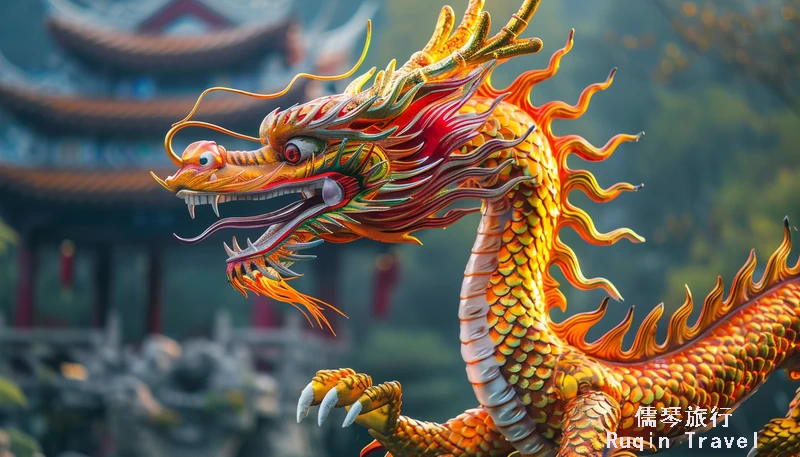The Chinese dragon, known as “lóng” (龙) in Mandarin, is one of the most iconic symbols in Chinese culture. Unlike the malevolent fire-breathing dragons of Western lore, the Chinese dragon is a benevolent creature, deeply revered for its wisdom, power, and ability to bring good fortune. For travelers to China, understanding the rich mythology, history, and symbolism of the dragon provides invaluable insight into Chinese traditions, art, and cultural practices.
1. The History of Chinese Dragons
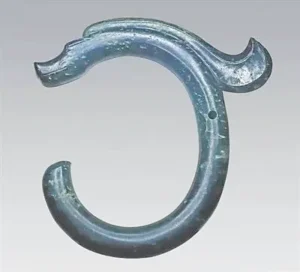
Neolithic Beginnings
The earliest evidence of dragon-like creatures in Chinese culture comes from the Hongshan culture (4700–2900 BCE), where jade artifacts resembling dragons were discovered.
The C-shaped jade dragons symbolize power and protection and are believed to be some of the earliest representations of the dragon as a sacred entity.
The Shang and Zhou Dynasties
By the Shang Dynasty (1600–1046 BCE), the dragon had become a prominent figure in Chinese art and religion. Oracle bones, used for divination, feature dragon motifs, suggesting their association with supernatural power and the divine.
During the Zhou Dynasty (1046–256 BCE), the dragon was further linked with water, agriculture, and rainfall. This connection was vital for ancient agrarian societies dependent on successful harvests.
The Han Dynasty and Beyond
By the time of the Han Dynasty (202 BCE–220 CE), the dragon was firmly established as a symbol of imperial authority. The Han emperors proclaimed themselves descendants of dragons, solidifying the creature’s role as a representation of supreme power and legitimacy.
Throughout the following dynasties, the dragon’s status remained unparalleled, adorning everything from imperial robes to palace roofs. The Five-Clawed Dragon, in particular, became an exclusive symbol of the emperor, with harsh penalties for anyone else daring to use it.
2. Myths of the Chinese Dragon
Creation Myths
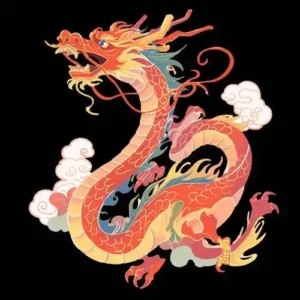
The origins of the Chinese dragon are rooted in ancient Chinese mythology. Early depictions of dragons date back thousands of years to the Neolithic era, where they appeared in pottery and jade carvings. Myths suggest the dragon evolved from the totem animals of various tribes, symbolizing unity and power.
One popular legend describes the dragon as a composite creature, formed by combining the most revered features of other animals:
The seven animal parts that make up the Chinese dragon, according to the popular legend:
| Animal Part | Feature | Symbolism |
|---|---|---|
| Antlers of a Deer | Majestic, branching antlers | Represents nobility and longevity |
| Head of a Camel | Unique and elongated head structure | Symbolizes endurance and resilience |
| Scales of a Fish | Shiny, overlapping scales | Denotes adaptability and the dragon’s connection to water |
| Claws of an Eagle | Sharp, powerful talons | Signifies strength and predatory prowess |
| Body of a Serpent | Long, sinuous form | Reflects flexibility, agility, and the dragon’s mystical nature |
| Eyes of a Demon | Fierce, penetrating gaze | Represents insight, power, and the ability to see all |
| Ears of an Ox | Large, rounded ears | Symbolizes attentiveness and the dragon’s connection to the earth |
This amalgamation reflects the Chinese dragon’s role as a guardian of the natural world, embodying the harmony of all creatures.
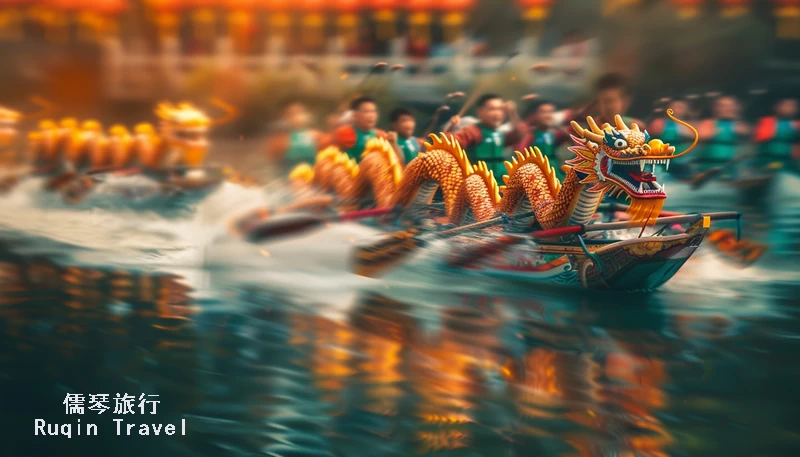
The Dragon Kings
Another myth centers on the Dragon Kings (龙王), who rule the four seas—north, south, east, and west. These powerful beings are not only protectors of their realms but also controllers of rain and water. Villagers often prayed to the Dragon Kings for rain during droughts, a tradition that continues in some rural areas to this day.
Dragons and Humans
Many Chinese myths tell of dragons interacting with humans. One famous story is of Emperor Yao, a mythical ruler, who was said to have been aided by a dragon in taming the floods of the Yellow River. In another tale, dragons serve as the steeds of deities, ferrying them across the heavens.
3. Symbolism of the Chinese Dragon
Power and Strength
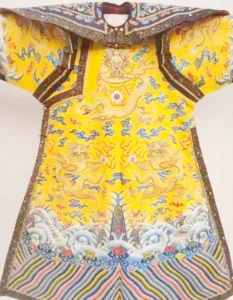
The Chinese dragon epitomizes power, strength, and resilience. As a celestial creature, it has unparalleled control over natural elements like water and wind, making it a symbol of authority and dominion.
A 龙袍 is a traditional Chinese imperial robe adorned with dragon motifs, worn exclusively by emperors during China’s dynastic periods. The dragon, typically depicted with five claws, symbolizes imperial authority, divine power, and the connection between the emperor and the heavens.
Good Fortune and Prosperity
Dragons are often associated with wealth and prosperity. In Chinese tradition, dragons bring rain, which was essential for agriculture and, by extension, survival and abundance. To this day, dragon imagery is frequently used in celebrations and business settings to invoke good luck and success.
Imperial Authority
For centuries, the dragon has been a direct representation of the emperor and the ruling elite. Imperial dragons often had five claws, while dragons with four claws were reserved for nobility. This distinction reflects the hierarchical nature of traditional Chinese society.
Harmony and Balance
Dragons are believed to embody the concept of yin and yang, the balance of opposing forces. As water creatures that can ascend to the heavens, dragons connect the earth and sky, symbolizing unity and harmony.
Protector and Guardian
In Chinese culture, dragons are protectors, guarding sacred sites and treasures. Stone dragon statues often flank entrances to temples and palaces, warding off evil spirits.
4. Chinese Dragons in Art and Architecture
Dragon Dance
Visitors to China may encounter the Dragon Dance (舞龙), especially during the Spring Festival (Chinese New Year). This vibrant performance involves dancers holding a long dragon figure on poles, mimicking its sinuous movements. The dance is believed to chase away evil spirits and bring good luck for the coming year.
Dragon on Imperial Structures
In imperial China, dragons adorned palaces, tombs, and official seals. One of the best-known examples is the Nine-Dragon Wall (九龙壁), found in places like the Forbidden City and Datong. These walls feature intricate carvings of nine dragons, a number associated with ultimate power and completeness.
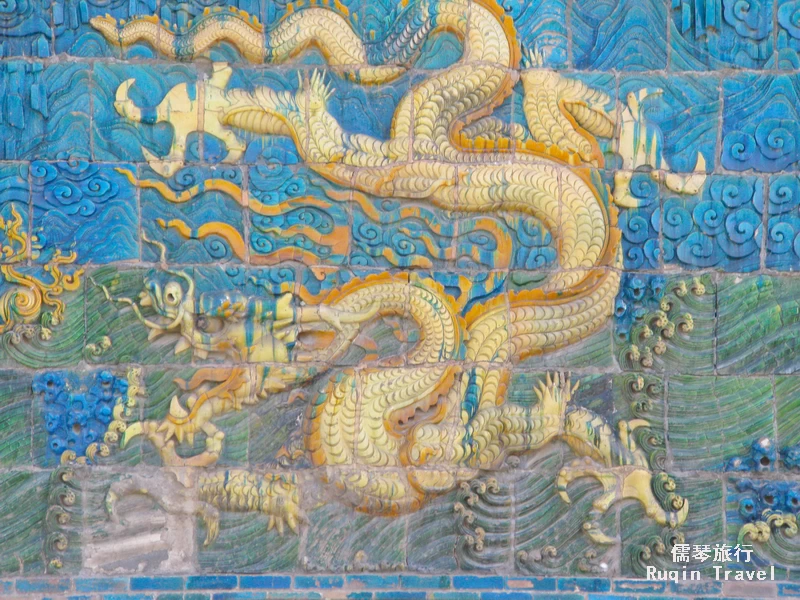
Literature and Poetry
Dragons frequently appear in Chinese literature and poetry as symbols of greatness, wisdom, or ambition. Poets like Li Bai and Du Fu used dragons metaphorically to convey lofty aspirations or divine inspiration.
Calligraphy and Painting
Chinese calligraphy and painting often feature dragons in dynamic poses, reflecting their energy and vitality. In ink-wash paintings, dragons are depicted soaring through clouds, a visual metaphor for transcendence and mystery.
5. Encountering Dragons During Your Travels in China
If you’re planning a trip to China, there are numerous places where you can explore the cultural significance of the Chinese dragon:
Forbidden City, Beijing

The Forbidden City, home to 24 emperors, is filled with dragon motifs. Look for the Golden Water Bridges and the emperor’s throne, where dragons appear as guardians of imperial power.
Nine-Dragon Wall, Datong
This stunning wall, made of glazed tiles, showcases nine intricately detailed dragons, each unique in color and design. It’s a masterpiece of Ming Dynasty craftsmanship.
Longmen Grottoes, Luoyang
The Longmen Grottoes feature Buddhist carvings with dragon imagery. These stunning works of art blend religious and mythological symbolism.
Dragon Well Tea Plantation, Hangzhou
For tea enthusiasts, the Dragon Well (Longjing) Tea Plantation is a must-visit. The area’s name comes from a legendary dragon said to live in a local well.
Yalong Bay, Hainan
This tropical destination is named after the “tooth of the dragon” and offers stunning beaches with dragon-related legends.
6. Dragon Symbolism in Modern China
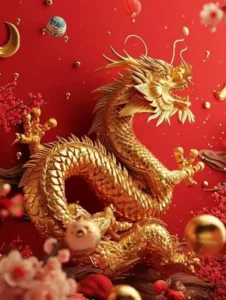
The dragon remains a potent symbol in contemporary China. It appears in everything from business logos to national celebrations. The Year of the Dragon, occurring every 12 years in the Chinese zodiac, is especially auspicious. People born in this year are thought to possess the dragon’s traits: ambition, courage, and charisma.
Modern China often refers to itself as the “Dragon of the East,” a proud acknowledgment of its cultural heritage and rising global influence.
7. Tips for Travelers: Engaging with Chinese Dragon Culture
- Learn the Basics of Respect: When visiting temples or sacred sites with dragon imagery, remember to behave respectfully—avoid touching sculptures or taking inappropriate photographs.
- Participate in Festivals: If your trip coincides with the Spring Festival, don’t miss the dragon dance performances, which are often held in public squares or at cultural events.
- Shop for Souvenirs: Look for dragon-themed souvenirs such as jade carvings, embroidered fabrics, or calligraphy scrolls. These make meaningful gifts and mementos.
- Appreciate the Art: Spend time studying the details of dragon artwork in museums and historical sites. Every curve and scale has symbolic significance.
- Ask Questions: Locals are often happy to share the legends and meanings behind the dragon in their region. Engaging with them can deepen your understanding and appreciation.
Conclusion
The Chinese dragon is much more than a mythical creature; it is a profound symbol of Chinese identity, history, and philosophy. Its presence in art, architecture, and cultural traditions reflects values such as harmony, strength, and resilience. For foreign travelers, exploring the myths, history, and symbolism of the Chinese dragon offers a unique window into the soul of China, enriching your journey and deepening your connection with this ancient land.
More China Cultural Insights
China is a country full of rich traditions, colorful festivals, and fascinating customs that have been passed down through generations. At China Cultural Insights by Ruqin China Travel, we want to help you experience the real China by understanding its culture.

